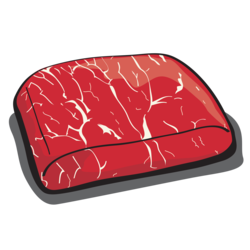AKA: Oyster Blade Steak, Butler's Steak, Lifter Steak, Petite Steak, Book Steak, Top Chuck Steak, Top Boneless Chuck
Primal: Chuck (US)
Cooking Methods: Grill, Pan-Fry, BBQ
Good For: Dinner Steak
Fat Content: Low
Price: Moderate

The Flat Iron Steak is obtained when the Top Blade Roast is cut into slices and does not comprise the connective tissue that affects the tenderization of Top Blade Roast. This makes it count among the relatively more tender cuts taken from the Beef Chuck. This cut contains a considerable amount of marbling.
Since it comes from the Chuck, Flat Iron Steak is not exactly the tenderest of cuts. This is the reason why it is considered a good option for braising and stewing. If marinated for a few hours in advance, this cut can prove to be a great choice for grilling as well. For best results, it should be grilled on medium-high heat. Care should be taken when it comes to the doneness of the meat as anything past medium will turn the steak’s texture dry and chewy. The cut is well-liked by many for its oozing beefy taste. It can be used as a substitute for any recipe that calls for a flat steak, such as Flank Steak or Skirt Steak.
Flat Iron Steak comprises the Infraspinatus muscles of the animal. It is taken from the Top Blade, which is right next to the middle of the shoulder clod and below the 7-bone.
The steak gets its name because it is thought to resemble a metal flat iron from the olden days.
The cut was introduced after researchers from University of Nebraska and University of Florida collaborated with restaurants and meat retailers to find a use for the Top Blade, which would typically be wasted due to the tough connective tissue running through it.
Popular Dishes: Grilled Steaks, Broiled Steaks, Stir-Fried BeefThis information about Flat Iron Steak was sourced from our meat cut app

